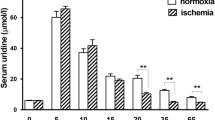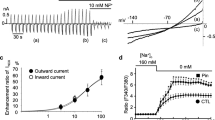Abstract
Glibenclamide, a K+ ATP channel antagonist, blocks the anti-infarct effect of ischemic preconditioning in rabbits, but only when the latter are anesthetized with ketamine-xylazine. Furthermore, the protection triggered by pinacidil, a K+ ATP channel opener, can be aborted by treatment with the adenosine antagonist 8-(P-sulfo-phenyl) theophylline. This study tests whether either the anesthetic regimen or glibenclamide affects infarct size by modulating interstitial adenosine levels. Interstitial adenosine and total purine concentrations were assessed in open-chest rabbits by the microdialysis technique. Dialysis fibers were inserted into myocardium served by a coronary artery branch surrounded by a snare. All animals sustained a 30-min coronary occlusion and then 120-min reperfusion. Rabbits were anesthetized with either sodium pentobarbital or a ketamine-xylazine mixture. Half of the latter animals also received glibenclamide. The control levels of adenosine in the dialysate were comparable in the three groups, as were those of total purines, and the infusion of glibenclamide caused no change. Ischemia led to 10- to 20-fold increases in interstitial adenosine and 10-to-40-fold rises in total purine concentrations. These increase were equivalent in all groups. Furthermore, infarct size as a percentage of the myocardium at risk was also comparable in the three groups. Neither the anesthetic agent nor glibenclamide appears to modulate interstitial adenosine release from ischemic tissue.
Similar content being viewed by others
References
Auchampach JA, Gross GJ (1993) Adenosine A1 receptors, KATP channels, and ischemic preconditioning in dogs. Am J Physiol 264: H1327-H1336
Auchampach JA, Maruyama M, Cavero I, Gross GJ (1991) The new K+ channel opener aprikalim (RP 52891) reduces experimental infarct size in dogs in the absence of hemodynamic changes. J Pharmacol Exp Ther 259: 961–967
Auchampach JA, Grover GJ, Gross GJ (1992) Blockade of ischaemic preconditioning in dogs by the novel ATP dependent potassium channel antagonist sodium 5-hydroxydecanoate. Cardiovasc Res 26: 1054–1062
Chan SLF, Dunne MJ, Stillings MR, Morgan NG (1991) Theα 2-adrenoceptor antagonist efaroxan modulates K+ ATP channels in insulin-secreting cells. Eur J Pharmacol 204: 41–48
Cole WC, McPherson CD, Sontag D (1991) ATP-regulated K+ channels protect the myocardium against ischemia/ reperfusion damage. Circ Res 69: 571–581
de Weille JR, Schmid-Antomarchi H, Fosset M, Lazdunski M (1989) Regulation of ATP-sensitive K+ channels in insulinoma cells: activation by somatostatin and protein kinase C and the role of cAMP. Proc Natl Acad Sci 86: 2971–2975
Downey JM (1993) An explanation for the reported observation that ATP dependent potassium channel openers mimic preconditioning. Cardiovasc Res 27: 1565
Dunne MJ (1991) Block of ATP-regulated potassium channels by phentolamine and other α-adrenoceptor antagonists. Br J Pharmacol 103: 1847–1850
Gross GJ, Auchampach JA (1992) Blockade of ATP-sensitive potassium channels prevents myocardial preconditioning in dogs. Circ Res 70: 223–233
Grover GJ, McCullough JR, Henry DE, Conder ML, Sleph PG (1989) Antiischemic effects of the potassium channel activators pinacidil and cromakalim and the reversal of these effects with the potassium channel blocker glyburide. J Pharmacol Exp Ther 251: 98–104
Grover GJ, Dzwonczyk S, Sleph PG (1990) Reduction of ischemic damage in isolated rat hearts by the potassium channel opener, RP 52891. Eur J Pharmacol 191: 11–18
Grover GJ, Sleph PG, Dzwonczyk S (1990) Pharmacologic profile of cromakalim in the treatment of myocardial ischemia in isolated rat hearts and anesthetized dogs. J Cardiovasc Pharmacol 16: 853–864
Grover GJ, Sleph PG, Dzwonczyk S (1992) Role of myocardial ATP-sensitive potassium channels in mediating preconditioning in the dog heart and their possible interaction with adenosine A1-receptors. Circulation 86: 1310–1316
Haessler R, Kuzume K, Chien GL, Wolff RA, Davis RF, Van Winkle DM (1994) Anaesthetics alter the magnitude of infarct limitation by ischaemic preconditioning. Cardiovasc Res 28: 1574–1580
Harding EA, Jaggar JH, Squires PE, Dunne MJ (1994) Polymyxin B has multiple blocking actions on the ATP-sensitive potassium channel in insulin-secreting cells. Pflugers Arch 426: 31–39
Hasséssian H, Bodin P, Burnstock G (1993) Blockade by glibenclamide of the flow-evoked endothelial release of ATP that contributes to vasodilatation in the pulmonary vascular bed of the rat. Br J Pharmacol 109: 466–472
Kirsch GE, Codina J, Birnbaumer L, Brown AM (1990) Coupling of ATP-sensitive K+ channels to A1 receptors by G proteins in rat ventricular myocytes. Am J Physiol 259: H820-H826
Li GC, Vasquez JA, Gallagher KP, Lucchesi BR (1990) Myocardial protection with preconditioning. Circulation 82: 609–619
Liu GS, Thornton J, Van Winkle DM, Stanley AWH, Olsson RA, Downey JM (1991) Protection against infarction afforded by preconditioning is mediated by A1 adenosine receptors in rabbit heart. Circulation 84: 350–356
Liu Y, Ytrehus K, Downey JM (1994) Evidence that translocation of protein kinase C is a key event during ischemic preconditioning of rabbit myocardium. J Mol Cell Cardiol 26: 661–668
Miura T, Iimura O (1993) Infarct size limitation by preconditioning: its phenomenological features and the key role of adenosine. Cardiovasc Res 27: 36–42
Murry CE, Jennings RB, Reimer KA (1986) Preconditioning with ischemia: a delay of lethal cell injury in ischemic myocardium. Circulation 74: 1124–1136
Schott RJ, Rohmann S, Braun ER, Schaper W (1990) Ischemic preconditioning reduces infarct size in swine myocardium. Circ Res 66: 1133–1142
Schulz R, Rose J, Martin C, Heusch G (1993) Activation of ATP-dependent potassium channels is involved in ischemic preconditioning in swine. Circulation 88 (suppl I): I-102
Schwarz ER, Mohri M, Sack S, Arras M (1991) The role of adenosine and its A1-receptor in ischemic preconditioning. Circulation 84 (Suppl II): II-191
Thornton JD, Thornton CS, Sterling DL, Downey JM (1993) Blockade of ATP-sensitive potassium channels increases infarct size but does not prevent preconditioning in rabbit hearts. Circ Res 72: 44–49
Toombs CF, Moore TL, Shebuski RJ (1993) Limitation of infarct size in the rabbit by ischaemic preconditioning is reversible with glibenclamide. Cardiovasc Res 27: 617–622
Van Wylen DGL (1994) Effect of ischemic preconditioning on interstitial purine metabolite and lactate accumulation during myocardial ischemia. Circulation 89: 2283–2289
Van Wylen DGL, Willis J, Sodhi J, Weiss RJ, Lasley RD, Mentzer RM Jr (1990) Cardiac microdialysis to estimate interstitial adenosine and coronary blood flow. Am J Physiol 258: H1642-H1649
Van Wylen DGL, Schmit TJ, Lasley RD, Gingell RL, Mentzer RM Jr (1992) Cardiac microdialysis in isolated rat hearts: interstitial purine metabolites during ischemia. Am J Physiol 262: H1934-H1938
Van Winkle DM, Chien GL, Wolff RA, Soifer BE, Kuzume K, Davis RF (1994) Cardioprotection provided by adenosine receptor activation is abolished by blockade of the KATP channel. Am J Physiol 266: H829-H839
Walsh RS, Tsuchida A, Daly JJF, Thornton JD, Cohen MV, Downey JM (1994) Ketamine-xylazine anaesthesia permits a KATP channel antagonist of attenuate preconditioning in rabbit myocardium. Cardiovasc Res 28: 1337–1341
Yao Z, Gross GJ (1994) A comparison of adenosine-induced cardioprotection and ischemic preconditioning in dogs: efficacy, time course, and role of KATP channels. Circulation 89: 1229–1236
Ytrehus K, Liu Y, Downey JM (1994) Preconditioning protects ischemic rab bit heart by protein kinase C activation. Am J Physiol 266: H1145-H1152
Author information
Authors and Affiliations
Additional information
This work was supported in part by grants from the National Institutes of Healt, Heart, Lung, and Blood Institute, HL-20468, HL-46027, and HL-50688 and Bristol Myers Squibb, and was performed during the tenure of an Established Investigator Award from the American Heart Association (DGLVW).
Rights and permissions
About this article
Cite this article
Cohen, M.V., Snell, K.S., Tsuchida, A. et al. Effects of anesthesia and K+ ATP channel blockade on interstitial adenosine accumulation in ischemic rabbit myocardium. Basic Res Cardiol 90, 410–417 (1995). https://doi.org/10.1007/BF00788503
Received:
Revised:
Accepted:
Issue Date:
DOI: https://doi.org/10.1007/BF00788503




